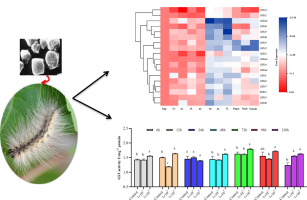当前位置:
X-MOL 学术
›
Pestic. Biochem. Phys.
›
论文详情
Our official English website, www.x-mol.net, welcomes your
feedback! (Note: you will need to create a separate account there.)
Characterisation of GST genes from the Hyphantria cunea and their response to the oxidative stress caused by the infection of Hyphantria cunea nucleopolyhedrovirus (HcNPV)
Pesticide Biochemistry and Physiology ( IF 4.2 ) Pub Date : 2020-02-01 , DOI: 10.1016/j.pestbp.2019.11.019 Lili Sun 1 , Jingjing Yin 1 , Hui Du 1 , Peng Liu 1 , Chuanwang Cao 1
Pesticide Biochemistry and Physiology ( IF 4.2 ) Pub Date : 2020-02-01 , DOI: 10.1016/j.pestbp.2019.11.019 Lili Sun 1 , Jingjing Yin 1 , Hui Du 1 , Peng Liu 1 , Chuanwang Cao 1
Affiliation

|
The fall webworm, Hyphantria cunea (Drury) (Lepidoptera: Noctuidae), is a major pest found in forests. In this study, the effects of Hyphantria cunea nucleopolyhedrovirus (HcNPV) infection on the transcription levels and activities of glutathione S-transferases (GSTs) in H. cunea were determined. In the present study, 18 GST family genes were identified from the H. cunea transcriptome dataset by using bioinformatic analyses. These GST genes were classified into cytosolic (15 genes) and microsomal (three genes) classes. The 15 cytosolic GST genes belonged to four different subclasses (epsilon, sigma and delta). The all GST genes, especially GSTe4, showed high expression levels in egg and 1st~4th instar larval stage while their low expression levels in 5th~7th instar larvae using real-time quantitative PCR analysis. However, the expression levels of the 18 GST genes were varied after exposure to sublethal doses of HcNPV. The expression levels of most GSTs were downregulated and upregulated at low and high concentrations of HcNPV, respectively. The corresponding total GST activities also showed similar patterns. In H. cunea, changes in the expression levels and enzymatic activities of GSTs after exposure to HcNPV indicated that they may have important functions in the defense against HcNPV, and the stress, which may be reflected by the high GST enzymatic activities.
中文翻译:

Hyphantria cunea 中 GST 基因的特征及其对 Hyphantria cunea 核多角体病毒 (HcNPV) 感染引起的氧化应激的反应
秋季网虫 Hyphantria cunea (Drury)(鳞翅目:夜蛾科)是一种在森林中发现的主要害虫。在这项研究中,确定了 Hyphantria cunea 核多角体病毒 (HcNPV) 感染对 H. cunea 中谷胱甘肽 S 转移酶 (GST) 的转录水平和活性的影响。在本研究中,通过使用生物信息学分析从 H.cunea 转录组数据集中鉴定了 18 个 GST 家族基因。这些 GST 基因分为细胞质(15 个基因)和微粒体(三个基因)类别。15 个胞质 GST 基因属于四个不同的亚类(epsilon、sigma 和 delta)。实时定量PCR分析表明,所有GST基因,特别是GSTe4,在卵和1~4龄幼虫中表达水平较高,而在5~7龄幼虫中表达水平较低。然而,暴露于亚致死剂量的 HcNPV 后,18 个 GST 基因的表达水平发生了变化。大多数 GST 的表达水平分别在低浓度和高浓度 HcNPV 下下调和上调。相应的总消费税活动也显示出类似的模式。HcNPV 暴露后 GSTs 表达水平和酶活性的变化表明,在 HcNPV 中,GSTs 的表达水平和酶活性的变化表明它们可能在抵御 HcNPV 和应激方面具有重要作用,这可能反映在高 GST 酶活性上。
更新日期:2020-02-01
中文翻译:

Hyphantria cunea 中 GST 基因的特征及其对 Hyphantria cunea 核多角体病毒 (HcNPV) 感染引起的氧化应激的反应
秋季网虫 Hyphantria cunea (Drury)(鳞翅目:夜蛾科)是一种在森林中发现的主要害虫。在这项研究中,确定了 Hyphantria cunea 核多角体病毒 (HcNPV) 感染对 H. cunea 中谷胱甘肽 S 转移酶 (GST) 的转录水平和活性的影响。在本研究中,通过使用生物信息学分析从 H.cunea 转录组数据集中鉴定了 18 个 GST 家族基因。这些 GST 基因分为细胞质(15 个基因)和微粒体(三个基因)类别。15 个胞质 GST 基因属于四个不同的亚类(epsilon、sigma 和 delta)。实时定量PCR分析表明,所有GST基因,特别是GSTe4,在卵和1~4龄幼虫中表达水平较高,而在5~7龄幼虫中表达水平较低。然而,暴露于亚致死剂量的 HcNPV 后,18 个 GST 基因的表达水平发生了变化。大多数 GST 的表达水平分别在低浓度和高浓度 HcNPV 下下调和上调。相应的总消费税活动也显示出类似的模式。HcNPV 暴露后 GSTs 表达水平和酶活性的变化表明,在 HcNPV 中,GSTs 的表达水平和酶活性的变化表明它们可能在抵御 HcNPV 和应激方面具有重要作用,这可能反映在高 GST 酶活性上。











































 京公网安备 11010802027423号
京公网安备 11010802027423号